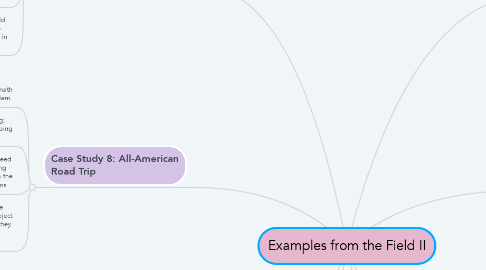Examples from the Field II
by Caitlyn Worry

1. Case Study 7: Life Science and Storybooks
1.1. This case focused on creating a connection between science and language arts. This allowed 7th graders to interact with 2nd graders and help each other learn.
1.2. Strengths: Integrated technology; cross-curricular learning; showed students how to work with the program first and showed what was expected
1.3. Weakness: Possibility of being limited in creativity
1.4. If I would decide to complete this, I would attempt to find a different application so that the students could be more creative in the story their creating.
2. Case Study 8: All-American Road Trip
2.1. This case focused on having 6th grade math students solve a "family" road trip problem.
2.2. Strengths: Cross-curricular learning; students were pushed past just doing simple problems
2.3. Weakness: Students would probably need to be strong in the math concepts being used; possibility of students relying on the tool to assist with some of the problems
2.4. If I would complete this, I would have the students move past just creating this project within the students home state, so that they have the opportunity to look at different states.
3. Case Study 9: Graphing Stories
3.1. This case focused on having students in the 9th grade, connect their everyday lives with math while using the technology that they work with everyday.
3.2. Strengths: predictions were made before students began working; connects real world with education
3.3. Weakness: possibility of misuse of technology
3.4. If I were to complete this idea, I would only have groups of two so that the work is equal. However, I think this idea is wonderful because it connects the real-world to the classroom.
4. Similarities
4.1. Usage of high-order thinking skills
4.2. Connects the real-world to the classroom
4.3. Align with Triple E Framework
4.4. Cross-Curricular learning
5. Case Study 10: Civilization Creation
5.1. This case focused on having 9th grade students connect history and recreate historical location and events through Minecraft.
5.2. Strengths: allowed for creativity; blended technology with history; cross-curricular learning
5.3. Weakness: really long process; could not be beneficial for students that aren't interested in video games
5.4. If I were to implement this into my classroom, I would first make the project shorter and then require students to cite their sources that they use.
6. Case Study 11: E-Mentors
6.1. This case focused on having 11th grade students build relationships with the community and give insight on what they should do for their future.
6.2. Strengths: development of life skills; worked with professionals in city; bridge the real world with the classroom
6.3. Weakness: possibility to have an the wrong mentor with student; no face to face interaction
6.4. If I were to implement this idea into my classroom, I would use this same idea, but I would also have students meet with their mentors face-to-face and not just communicate electronically.
7. Case Study 12: Simulated Gaming
7.1. This case focused on having students communicate with friends and mentors through technology.
7.2. Strengths: creates a connection of the classroom to the real-world
7.3. Weakness: not geared for younger students
7.4. If I were to implement this I would attempt to find a way to use this in the younger levels and still have the success that was seen here.
8. Differences
8.1. range of subjects discussed
8.2. Different tools used in each case


